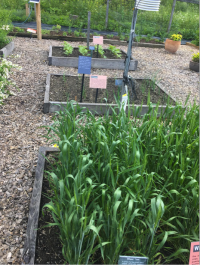What's happening this year
Friday, June 30, 2017
Hi there! I’m Amanda, this year’s Cornell Botanic Gardens Education intern here in the Climate Change Garden. I am very excited to be involved in this garden’s fourth year as I see it as a valuable tool to demonstrate the effects of climate change to the public. I hope to learn how the project team will continue to use the garden as a medium for education.
In my first few weeks in the garden, I have spent much of my time learning about the protocols for water and temperature that are necessary to model the potential effects of climate change on plants in 2050. In this time, I have seen drastic changes in the plants between those outside and inside of the high tunnel.
This year’s project beds include both perennials and annual food crops. The perennials include Hypericum (prolificum and kalmianum ‘Blues Festival’), Penstemon (hirsutus and digitalis), and Monarda (dydima and fistulosa). The food crops include wheat (‘Tom,’ ‘Glenn,’ and ‘Red Fife’), onions (‘Aisla Craig’), and dry beans (black beans ‘A-55’).
 When I first started working, many of the food crops were not yet established. Now, we have wheat, onions, and beans all growing! We expected the onions to do better than those in the tunnel, but they are not doing well at all. Despite the cooler temperatures outside, the combined effects of greater wind exposure and solar radiation prevented the onions from establishing well. Inside, the onions are doing very well! Another plant type displaying major discrepancies between the inside and outside is wheat. Inside the tunnel, the wheat has already begun to head up. This early “Boot Stage” will most likely cause lower production yields and lower biomass of the plants.
When I first started working, many of the food crops were not yet established. Now, we have wheat, onions, and beans all growing! We expected the onions to do better than those in the tunnel, but they are not doing well at all. Despite the cooler temperatures outside, the combined effects of greater wind exposure and solar radiation prevented the onions from establishing well. Inside, the onions are doing very well! Another plant type displaying major discrepancies between the inside and outside is wheat. Inside the tunnel, the wheat has already begun to head up. This early “Boot Stage” will most likely cause lower production yields and lower biomass of the plants.
Shown left: Outside photos of the food crops from week 1 of my internship.)
Bottom left:Outside photos of the food crops from week 3 of my internship
Bottom right: Can you notice the differences in growth of the food plants inside the high tunnel at week 3?











